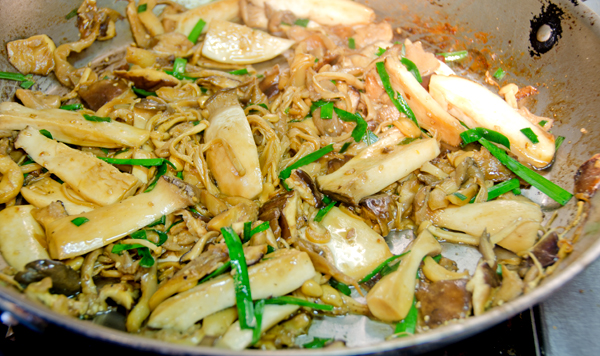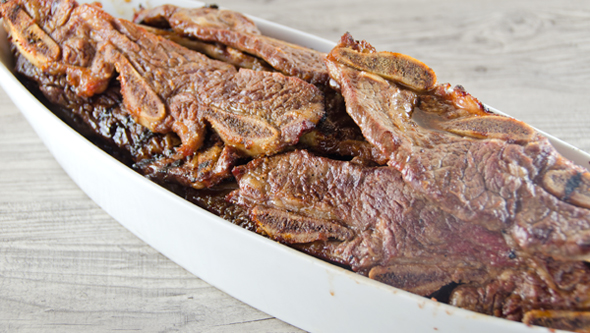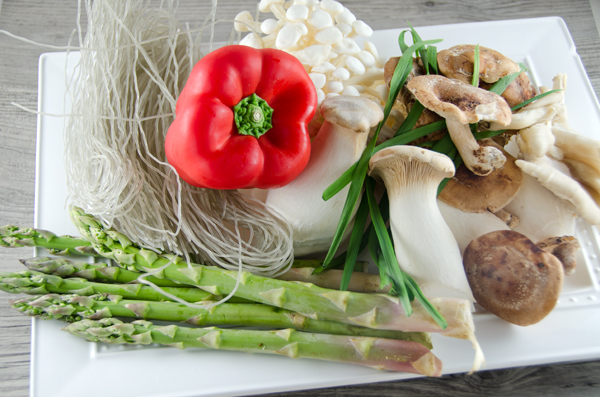
With the ingredients needed for the Korean barbecue now in hand it was time to start prepping for Sunday’s feast. One of the most important things I learned from my catering days is that it is good to have as much ready ahead of time as possible. This allows adequate time for dishes that require last minute preparation and eliminates a last minute rush.
First on my list was to make the marinades for the beef and the chicken. Kalbi or Galbi means rib in Korean and is one of the most popular Korean dishes in America.
Kalbi are beef short ribs that are cut flanken style. Flanken means the ribs are not cut along the bone, but across the bone leaving 2-3 rib cross sections in each piece. The marinade of soy, sugar, apple juice, sesame oil, ginger and garlic gives the traditional sweetness with just a hint of spice to the meat. Korean barbecued chicken or dak gogi called for boneless skinless chicken thighs cut into strips. Since Joe prefers to cook chicken on the bone we used bone-in chicken thighs. In this recipe I needed to substitute the mul yut (malt syrup) with corn syrup which was acceptable. The chicken recipe called for an essential Korean ingredient, gochugaru, which are red chili flakes. I was only able to find powdered red pepper so I turned to my pantry and made flakes from my own dried Kung Pao peppers. Now if I would only remember not to inhale the fumes when I open the food processor bowl. Wicked stuff! The marinade ingredients for the chicken were similar to the beef, the big difference were the chili flakes. Both the beef and the chicken would be served with ssamjang, translated “wrapped sauce”. Pieces of chicken or beef with a little plain white rice and the ssamjang are wrapped in lettuce leaves for a delicious bite also known as ssams. Ssamjang is made with dwenjang, a fermented bean paste and gochujang, the red chile paste I mentioned in the previous post. Roasted sesame seeds and sesame oil add texture and an inviting aroma to this sauce.
The banchan are the side dishes served with a Korean meal. For the lightly pickled radish dish I substituted Japanese Hakurei turnips from our garden for daikon used in the original recipe. The turnips were pickled with rice vinegar, sugar and garlic with a little bit of chili flakes for some heat. Korean spinach is a room temperature dish seasoned with soy, garlic and both toasted sesame oil and white sesame seeds. I’m seeing a pattern here. I added japchae, a noodle salad to the banchan that was not part of the original menu. Japchae is made with sweet potato noodles or dangmyeon. I expected the noodles would be orange or yellow in color but the dangmyeon were a translucent gray. The noodles were rehydrated in hot water then stir fried with soy, sugar, garlic and sesame oil and tossed with asparagus and a variety of mushrooms.
The dish that surprised me the most was the kimchi (alternately spelled kimchee). I read that the average Korean consumes 40 pounds of kimchi a year and it is eaten with just about every meal. I never thought that I would make kimchi, I have always found the pungent aroma of fermented cabbage and garlic to be a bit off putting. I learned there are countless variations of kimchi, not everyone using cabbage. This version uses cool, crisp Kirby cucumbers and takes only one day, not the 3 plus days traditional kimchi takes to make. The cucumbers are salted to bring out excess liquid and seasoned with garlic, chiles and scallions. The cucumber kimchi sits at room temperature overnight to ferment. Very pungent salted shrimp, saeujeot, bring umami to the finished dish. I am pleased to say that we had no left over kimchi at the end of our meal. Our meal finished with Kathy’s delicious sweet potato doughnuts. The Korean experience was enjoyed by all.






